2006 PONTIAC GRAND PRIX flat tire
[x] Cancel search: flat tirePage 383 of 472

Tire Chains
{CAUTION:
If your vehicle has P225/55R17, P255/45R18 or
P225/50R18 size tires, do not use tire chains,
there is not enough clearance.
Tire chains used on a vehicle without the
proper amount of clearance can cause damage
to the brakes, suspension or other vehicle
parts. The area damaged by the tire chains
could cause you to lose control of your vehicle
and you or others may be injured in a crash.
Use another type of traction device only if its
manufacturer recommends it for use on your
vehicle and tire size combination and road
conditions. Follow that manufacturer’s
instructions. To help avoid damage to your
vehicle, drive slowly, readjust or remove the
device if it is contacting your vehicle, and do
not spin your wheels.
If you do �nd traction devices that will �t,
install them on the front tires.Notice:If your vehicle does not have P225/55R17,
P255/45R18 or P225/50R18 size tires, use tire chains
only where legal and only when you must. Use only
SAE Class S-type chains that are the proper size for
your tires. Install them on the front tires and tighten
them as tightly as possible with the ends securely
fastened. Drive slowly and follow the chain
manufacturer’s instructions. If you can hear the
chains contacting your vehicle, stop and retighten
them. If the contact continues, slow down until it
stops. Driving too fast or spinning the wheels with
chains on will damage your vehicle.
If a Tire Goes Flat
It is unusual for a tire to blowout while you are driving,
especially if you maintain your tires properly. See
Tires on page 5-60. If air goes out of a tire, it is much
more likely to leak out slowly. But if you should ever
have a blowout, here are a few tips about what to expect
and what to do:
If a front tire fails, the �at tire will create a drag that
pulls the vehicle toward that side. Take your foot off the
accelerator pedal and grip the steering wheel �rmly.
Steer to maintain lane position, and then gently brake to
a stop well out of the traffic lane.
5-77
Page 384 of 472
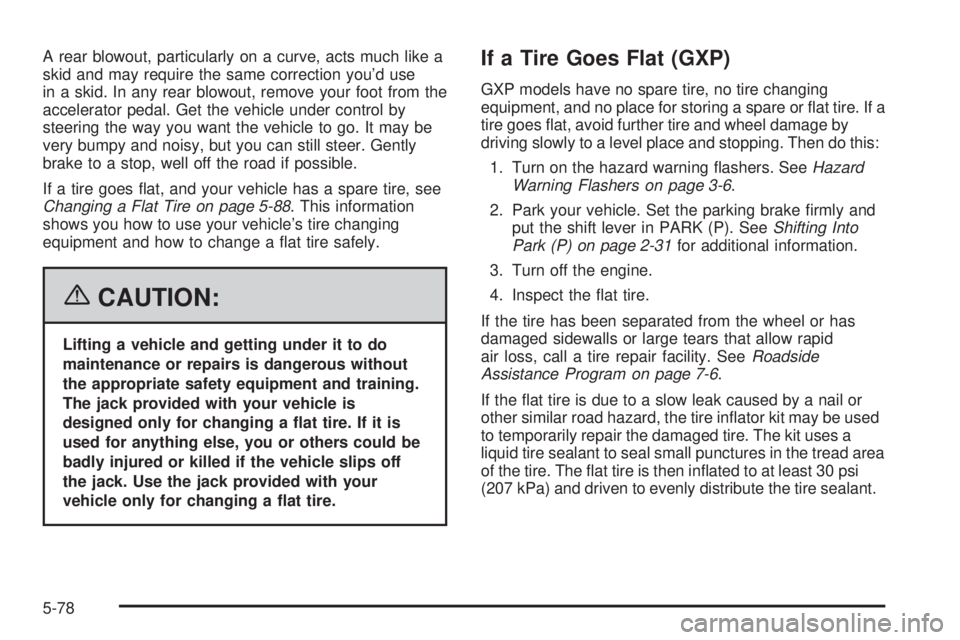
A rear blowout, particularly on a curve, acts much like a
skid and may require the same correction you’d use
in a skid. In any rear blowout, remove your foot from the
accelerator pedal. Get the vehicle under control by
steering the way you want the vehicle to go. It may be
very bumpy and noisy, but you can still steer. Gently
brake to a stop, well off the road if possible.
If a tire goes �at, and your vehicle has a spare tire, see
Changing a Flat Tire on page 5-88. This information
shows you how to use your vehicle’s tire changing
equipment and how to change a �at tire safely.
{CAUTION:
Lifting a vehicle and getting under it to do
maintenance or repairs is dangerous without
the appropriate safety equipment and training.
The jack provided with your vehicle is
designed only for changing a �at tire. If it is
used for anything else, you or others could be
badly injured or killed if the vehicle slips off
the jack. Use the jack provided with your
vehicle only for changing a �at tire.
If a Tire Goes Flat (GXP)
GXP models have no spare tire, no tire changing
equipment, and no place for storing a spare or �at tire. If a
tire goes �at, avoid further tire and wheel damage by
driving slowly to a level place and stopping. Then do this:
1. Turn on the hazard warning �ashers. SeeHazard
Warning Flashers on page 3-6.
2. Park your vehicle. Set the parking brake �rmly and
put the shift lever in PARK (P). SeeShifting Into
Park (P) on page 2-31for additional information.
3. Turn off the engine.
4. Inspect the �at tire.
If the tire has been separated from the wheel or has
damaged sidewalls or large tears that allow rapid
air loss, call a tire repair facility. SeeRoadside
Assistance Program on page 7-6.
If the �at tire is due to a slow leak caused by a nail or
other similar road hazard, the tire in�ator kit may be used
to temporarily repair the damaged tire. The kit uses a
liquid tire sealant to seal small punctures in the tread area
of the tire. The �at tire is then in�ated to at least 30 psi
(207 kPa) and driven to evenly distribute the tire sealant.
5-78
Page 394 of 472
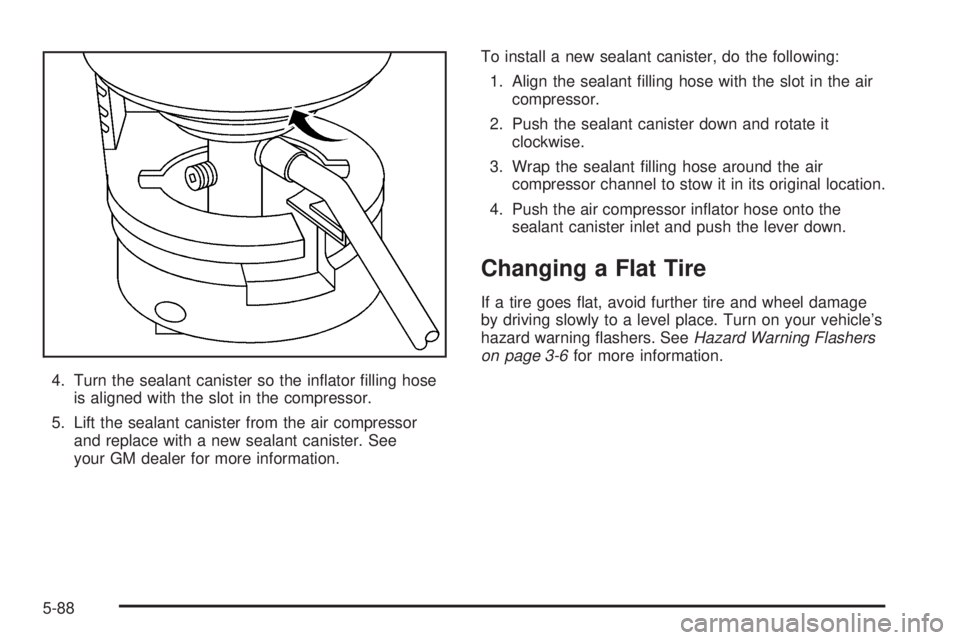
4. Turn the sealant canister so the in�ator �lling hose
is aligned with the slot in the compressor.
5. Lift the sealant canister from the air compressor
and replace with a new sealant canister. See
your GM dealer for more information.To install a new sealant canister, do the following:
1. Align the sealant �lling hose with the slot in the air
compressor.
2. Push the sealant canister down and rotate it
clockwise.
3. Wrap the sealant �lling hose around the air
compressor channel to stow it in its original location.
4. Push the air compressor in�ator hose onto the
sealant canister inlet and push the lever down.
Changing a Flat Tire
If a tire goes �at, avoid further tire and wheel damage
by driving slowly to a level place. Turn on your vehicle’s
hazard warning �ashers. SeeHazard Warning Flashers
on page 3-6for more information.
5-88
Page 397 of 472
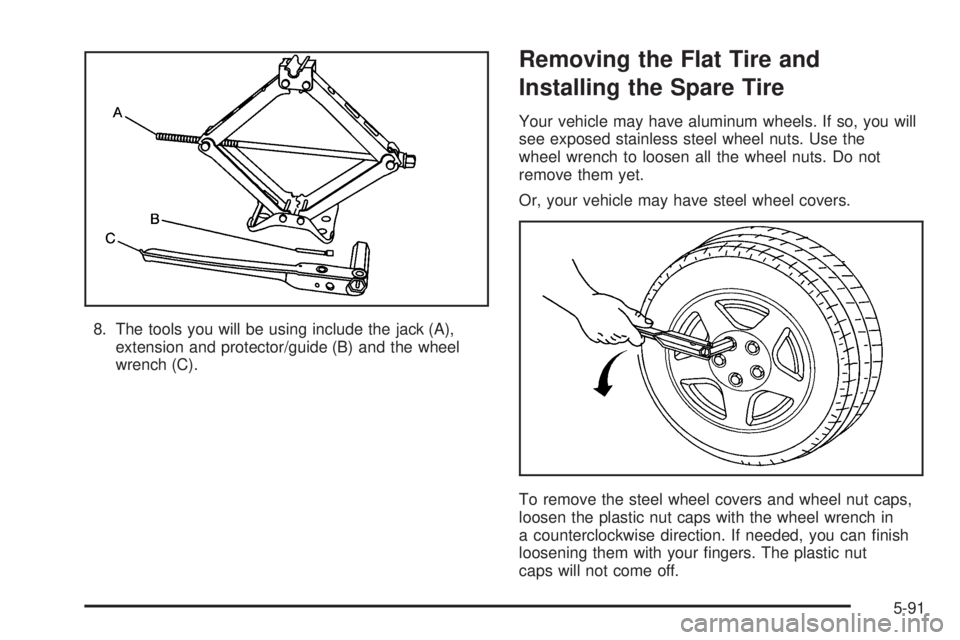
8. The tools you will be using include the jack (A),
extension and protector/guide (B) and the wheel
wrench (C).
Removing the Flat Tire and
Installing the Spare Tire
Your vehicle may have aluminum wheels. If so, you will
see exposed stainless steel wheel nuts. Use the
wheel wrench to loosen all the wheel nuts. Do not
remove them yet.
Or, your vehicle may have steel wheel covers.
To remove the steel wheel covers and wheel nut caps,
loosen the plastic nut caps with the wheel wrench in
a counterclockwise direction. If needed, you can �nish
loosening them with your �ngers. The plastic nut
caps will not come off.
5-91
Page 403 of 472
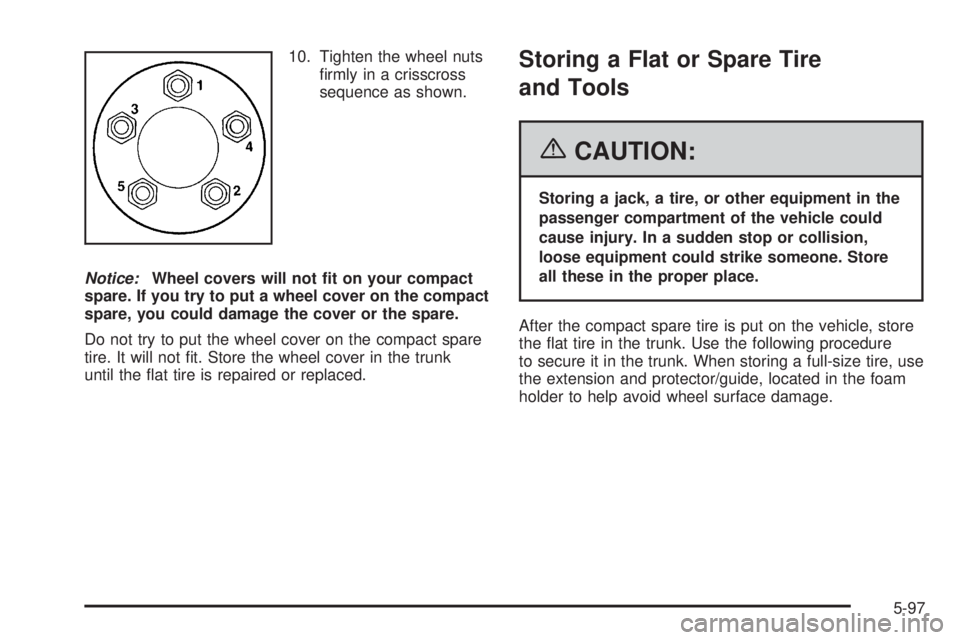
10. Tighten the wheel nuts
�rmly in a crisscross
sequence as shown.
Notice:Wheel covers will not �t on your compact
spare. If you try to put a wheel cover on the compact
spare, you could damage the cover or the spare.
Do not try to put the wheel cover on the compact spare
tire. It will not �t. Store the wheel cover in the trunk
until the �at tire is repaired or replaced.Storing a Flat or Spare Tire
and Tools
{CAUTION:
Storing a jack, a tire, or other equipment in the
passenger compartment of the vehicle could
cause injury. In a sudden stop or collision,
loose equipment could strike someone. Store
all these in the proper place.
After the compact spare tire is put on the vehicle, store
the �at tire in the trunk. Use the following procedure
to secure it in the trunk. When storing a full-size tire, use
the extension and protector/guide, located in the foam
holder to help avoid wheel surface damage.
5-97
Page 435 of 472
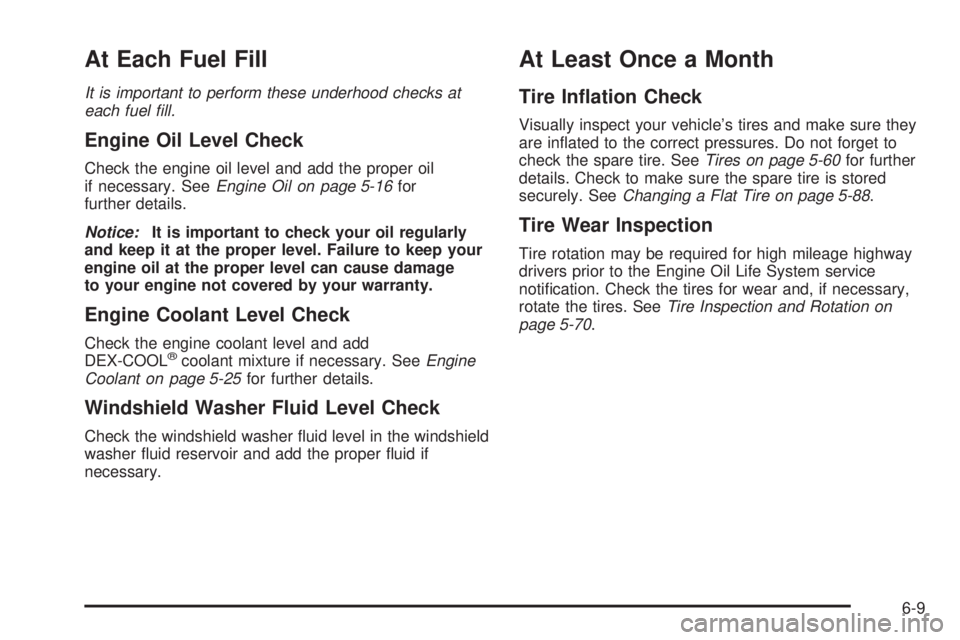
At Each Fuel Fill
It is important to perform these underhood checks at
each fuel �ll.
Engine Oil Level Check
Check the engine oil level and add the proper oil
if necessary. SeeEngine Oil on page 5-16for
further details.
Notice:It is important to check your oil regularly
and keep it at the proper level. Failure to keep your
engine oil at the proper level can cause damage
to your engine not covered by your warranty.
Engine Coolant Level Check
Check the engine coolant level and add
DEX-COOL®coolant mixture if necessary. SeeEngine
Coolant on page 5-25for further details.
Windshield Washer Fluid Level Check
Check the windshield washer �uid level in the windshield
washer �uid reservoir and add the proper �uid if
necessary.
At Least Once a Month
Tire In�ation Check
Visually inspect your vehicle’s tires and make sure they
are in�ated to the correct pressures. Do not forget to
check the spare tire. SeeTires on page 5-60for further
details. Check to make sure the spare tire is stored
securely. SeeChanging a Flat Tire on page 5-88.
Tire Wear Inspection
Tire rotation may be required for high mileage highway
drivers prior to the Engine Oil Life System service
noti�cation. Check the tires for wear and, if necessary,
rotate the tires. SeeTire Inspection and Rotation on
page 5-70.
6-9
Page 448 of 472
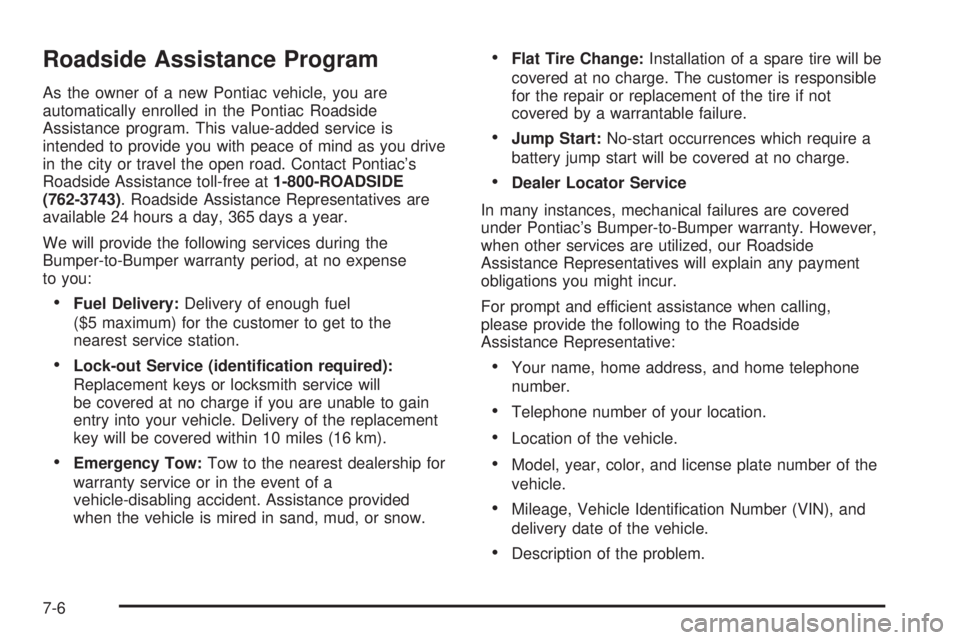
Roadside Assistance Program
As the owner of a new Pontiac vehicle, you are
automatically enrolled in the Pontiac Roadside
Assistance program. This value-added service is
intended to provide you with peace of mind as you drive
in the city or travel the open road. Contact Pontiac’s
Roadside Assistance toll-free at1-800-ROADSIDE
(762-3743). Roadside Assistance Representatives are
available 24 hours a day, 365 days a year.
We will provide the following services during the
Bumper-to-Bumper warranty period, at no expense
to you:
Fuel Delivery:Delivery of enough fuel
($5 maximum) for the customer to get to the
nearest service station.
Lock-out Service (identi�cation required):
Replacement keys or locksmith service will
be covered at no charge if you are unable to gain
entry into your vehicle. Delivery of the replacement
key will be covered within 10 miles (16 km).
Emergency Tow:Tow to the nearest dealership for
warranty service or in the event of a
vehicle-disabling accident. Assistance provided
when the vehicle is mired in sand, mud, or snow.
Flat Tire Change:Installation of a spare tire will be
covered at no charge. The customer is responsible
for the repair or replacement of the tire if not
covered by a warrantable failure.
Jump Start:No-start occurrences which require a
battery jump start will be covered at no charge.
Dealer Locator Service
In many instances, mechanical failures are covered
under Pontiac’s Bumper-to-Bumper warranty. However,
when other services are utilized, our Roadside
Assistance Representatives will explain any payment
obligations you might incur.
For prompt and efficient assistance when calling,
please provide the following to the Roadside
Assistance Representative:
Your name, home address, and home telephone
number.
Telephone number of your location.
Location of the vehicle.
Model, year, color, and license plate number of the
vehicle.
Mileage, Vehicle Identi�cation Number (VIN), and
delivery date of the vehicle.
Description of the problem.
7-6
Page 463 of 472

Engine (cont.)
Overheating................................................5-28
Starting......................................................2-23
Supercharger Oil.........................................5-20
Enhanced Traction System (ETS)......................4-11
Warning Light.............................................3-45
Entry Lighting.................................................3-18
Event Data Recorders (EDR)............................. 7-9
Extender, Safety Belt.......................................1-29
Exterior Lamps...............................................3-15
Exterior Lighting Battery Saver..........................3-17
F
Filter
Engine Air Cleaner......................................5-21
Finish Damage.............................................5-107
Flash-to-Pass................................................... 3-9
Flat Tire........................................................5-77
Flat Tire, Changing.........................................5-88
Flat Tire, Storing.............................................5-97
Fluid
Automatic Transaxle.....................................5-23
Power Steering...........................................5-40
Windshield Washer......................................5-41
Fog Lamp Light..............................................3-50
Fog Lamps....................................................3-17
Folding Rear Seat............................................ 1-9
Folding Seatback, Passenger............................. 1-7Front Reading Lamps......................................3-20
Front Seat Storage Net....................................2-42
Fuel............................................................... 5-5
Additives...................................................... 5-6
California Fuel.............................................. 5-6
Filling a Portable Fuel Container..................... 5-9
Filling Your Tank........................................... 5-7
Fuels in Foreign Countries.............................. 5-7
Gage.........................................................3-51
Gasoline Octane........................................... 5-5
Gasoline Speci�cations.................................. 5-5
Fuses
Fuses and Circuit Breakers.........................5-112
Instrument Panel Fuse Block.......................5-112
Underhood Fuse Block...............................5-114
Windshield Wiper.......................................5-111
G
Gage
Engine Coolant Temperature.........................3-46
Fuel..........................................................3-51
Speedometer..............................................3-37
Tachometer.................................................3-37
Gasoline
Octane........................................................ 5-5
Speci�cations............................................... 5-5
Glove Box.....................................................2-40
GM Mobility Reimbursement Program.................. 7-5
5